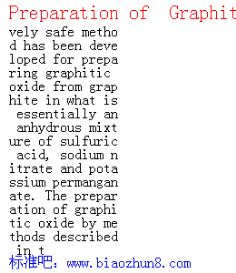Preparation of Graphitic Oxide
时间:2013-7-12 10:59:28 作者:345534464 来源:Pr 阅读:5169次

relatively safe method has been developed for preparing graphitic oxide from graphite in what is essentially an anhydrous
mixture of sulfuric acid, sodium nitrate and potassium permanganate.
The preparation of graphitic oxide by methods described in the literature is time consuming and hazardous.
Introduction
Graphitic oxide, sometimes called graphitic acid,
has been known for almost a century. It-was
first prepared by Brodie2 in 1859 by repeated
treatment of Ceylon graphite with an oxidation
mixture consisting of potassium chlorate and fum-
ing nitric acid. Since then, many other procedures
have been devised for forming graphitic oxide,
nearly all dependent upon strong oxidizing mix-
tures containing one or more concentrated acids
and oxidizing material~.~-s
The methods most commonly used at the pres-
ent time are the original Brodie synthesis and one
described by Staudenmaier,6 in which the graphite
is oxidized in concentrated sulfuric and nitric acids
with potassium chlorate. Recent workers in the
field such as Hofmann and Frenzels and Hamdi7
using the Staudenmaier method found the process
time consuming and hazardous. The Stauden-
niaier-Hofmann-Hamdi method involved the ad-
dition of potassium chlorate to a mixture of con-
centrated sulfuric acid, concentrated (63%) nitric
acid and graphite. The potassium chlorate was
stirred slowly and carefully into the mixture over a
period of one week with cooling. The chlorine
dioxide evolved was removed with an inert gas
such as carbon dioxide or nitrogen. The process
required more than 10 g. of potassium chlorate for
each gram of treated graphite and explosion was a
constant hazard.
In the present method,8 the oxidation of graphite
to graphitic oxide is accomplished by treating
graphite with essentially a water-free mixture of
concentrated sulfuric acid, sodium nitrate and
potassium permanganate. The entire process re-
quires less than two hours for completion at tem-
peratures below 45' and can be carried out safely
providing reasonable care is maintained in observ-
ing the temperature limitations.
Experimental
The graphitic oxide was prepared by stirring 100 g. of
powdered flake graphite (Dixon's 8635, 325 mesh) and 50 g.
of sodium nitrate into 2.3 liters of 66' Be technical sulfuric
acid. The ingredients were mixed in a 15-liter battery jar
that had been cooled to 0' in an ice-bath as a safety measure.
While maintaining vigorous agitation, 300 g. of potassium
permanganate was added to the suspension. The rate of
(1) This research conducted under National Lead Company Fellow-
ship at the Mellon Institute of Industrial Research.
(2) B. Brodie, Phil. Trans.. 149, 249 (1869).
(3) B. R. Brown and 0. W. Storey, Trans. Amur. Elcclrochcm. Soc.,
(4) G. Charpy, Compf. rend., 148, 920 (1909).
(6) U. Hofmann and A. Frenzel, Bct., 898, 1248 (1930).
(6) L. Staudenmaler, ibid., 31, 1481 (1898); 81, 1394 (1899); 88,
(7) H. Hamdi, Kolloid Briheffc, 64, 654 (1943).
(8) W. S. Hummers, U. S Patent No. 2,798,878 (1967).
69,129 (1928).
a824 (1900).
addition was controlled carefully to yevent the temperature
of the suspension from exceeding 20 .
The ice-bath was then removed and the temperature of
the suspension brought to 35 f 3O, where it was maintained
for 30 minutes. As the reaction progressed, the mixture
gradually thickened with a diminishing in effervescence.
At the end of 20 minutes, the mixture became pasty with
evolution of only a small amount of gas. The paste was
brownish grey in color.
At the end of 30 minutes, 4.6 liters of water was slowly
stirred into the paste, causing violent effervescence and an
increase in temperature to 98'. The diluted suspension,
now brown in color, was maintained at this temperature for
15 minutes. The suspension was then further diluted to
approximately 14 liters with warm water and treated with
37, hydrogen peroxide to reduce the residual permanganate
and manganese dioxide to colorless soluble manganese sul-
fate. Upon treatment with the peroxide, the suspension
turned bright yellow. The suspension was filtered resulting
in a yellow-brown filter cake. The filtering was conducted
while the suspension was still warm to avoid precipitation
of the slightly soluble salt of mellitic acid8 formed as a side
reaction.
After washing the yellowish-brown filter cake three times
with a total of 14 liters of warm water, the graphitic oxide
residue was dispersed in 32 liters of water to approximately
0.570 solids. The remaining salt impurities were removed
by treating with resinous anion and cation exchangers. The
dry form of graphitic oxide was obtained by centrifugation
followed by dehydration at 40" over phosphorus pentoxide
zn vacuo.
Results
The effectiveness of the oxidation method can be
judged by the proportion of graphitic oxide in the
product or by its carbon to oxygen ratio. Well
reacted samples of graphitic oxide will have a car-
bon to oxygen atomic ratio lying between 2.1 and
2.9. Also the color of the product when suspended
in water may be used as criterion for the degree of
oxidation of the graphite. The product richest in
graphitic oxide will have a bright yellow color
whereas poorer samples with higher carbon-to-
oxygen ratios will have a green to black hue.
An analysis of the dried graphitic oxide prepared
by the present method is compared in Table I with
a sample made by the Staudenmaier procedure.
The present synthesis resulted in approximately
188 g. of graphitic oxide containing 23% water
and 2% ash. The carbon and hydrogen were de-
termined by the combustion of graphitic oxide with
cupric oxide.Q l1
TABLE I Carbon-
to-
oxxen
% by weight atomic
Method Carbon Owaen Water Ash ratio .-
Acid-permanga-
nate-nitrate 47.06 27.97 22.99 1.98 2.25
Staudenmaier 52.11 23.99 22.22 1.90 2.89
HOUSTON, TEXAS
(9) B. Juettner, THIS JOURNAL, 59, 208 (1937).
(10) W. A. Selvis and W. C. Ratliff, Trans. Amer. Elcclrochcm. SOC.,
(11) H. Tbiele, 2. onorg. allpcm. Chrm., 190, 145 (1930).
1'7, 121 (1920).5169

下载说明:
1.请先分享,再下载
2.直接单击下载地址,不要使用“目标另存为”
3.压缩文件请先解压
4.PDF文件,请用PDF专用软件打开查看
5.如果资料不能下载,请联系本站